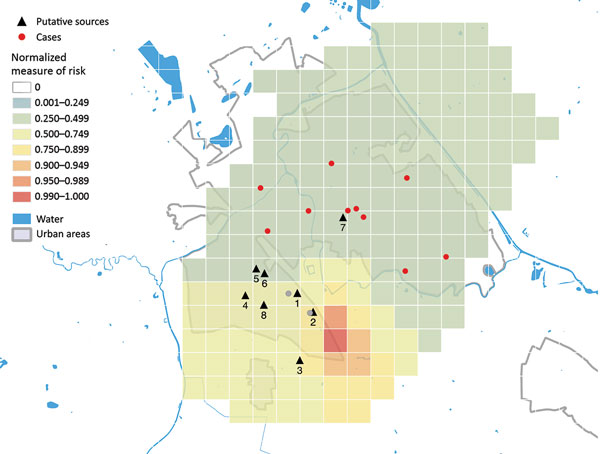Two Community Clusters of Legionnaires’ Disease Directly Linked to a Biologic Wastewater Treatment Plant, the Netherlands
Anna D. Loenenbach

, Christian Beulens, Sjoerd M. Euser, Jeroen P.G. van Leuken, Ben Bom, Wim van der Hoek, Ana Maria de Roda Husman, Wilhelmina L.M. Ruijs, Alvin A. Bartels, Ariene Rietveld, Jeroen W. den Boer, and Petra S. Brandsema
Author affiliations: European Centre for Disease Prevention and Control, Stockholm, Sweden (A.D. Loenenbach); National Institute for Public Health and the Environment, Bilthoven, the Netherlands (A.D. Loenenbach, J.P.G. van Leuken, B. Bom, W. van der Hoek, A.M. de Roda Husman, W.L.M. Ruijs, A.A. Bartels, P.S. Brandsema); Municipal Health Service Hart voor Brabant, ’s-Hertogenbosch, Tilburg, the Netherlands (C. Beulens, A. Rietveld); Regional Public Health Laboratory Kennemerland, Haarlem, the Netherlands (S.M. Euser, J.W. den Boer); Utrecht University, Utrecht, the Netherlands (A.M. de Roda Husman)
Main Article
Figure 2

Figure 2. Map of the norrmalized measure of risk for Legionnaires’ disease, Boxtel, the Netherlands, October 2016–December 2017. Results are based on case-patients living in Boxtel who constituted the clusters occurring in 2016 and 2017 (n = 11). Red dots indicate the residential address (postal code) of case-patients. A hotspot is an area with a measure of risk >0.9. Gray dots indicate Legionnaires’ disease cases in nonresidents; these cases are not included in the model. Black triangles indicate the putative sources: 1, biologic waste water treatment plant (industrial area); 2, wet cooling tower next to the biologic wastewater treatment plant (industrial area); 3–6, wet cooling towers (industrial area); 7, fountain (city center); 8, misting device (industrial area).
Main Article
Page created: September 16, 2018
Page updated: September 16, 2018
Page reviewed: September 16, 2018
The conclusions, findings, and opinions expressed by authors contributing to this journal do not necessarily reflect the official position of the U.S. Department of Health and Human Services, the Public Health Service, the Centers for Disease Control and Prevention, or the authors' affiliated institutions. Use of trade names is for identification only and does not imply endorsement by any of the groups named above.
